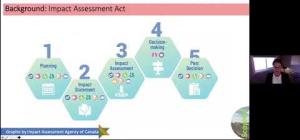
Health in impact assessments for natural resource and large infrastructure developments – opportunities for public health

Background
The incorporation of health considerations in decision making related to projects, policies and programs has become increasingly common. These considerations range from the benefits of planned green urban spaces to the risks of surface water pollution from mining operations. Within this context, Health Impact Assessment (HIA) has emerged as an important framework for integrating health criteria when proposals for non-health projects are being appraised. HIA is a systematic framework that evaluates positive and negative health impacts. It can inform decisions on whether to approve, defer or require changes to a proposal.
In 2019 Canada put in place new legislation, the Impact Assessment (IA) Act. In contrast to earlier legislation (The Canadian Environmental Assessment (CEA) Act (2012)), the IA Act requires the inclusion of health outcomes in the IA process for natural resource and major infrastructure developments. The implications of this new legislation for the use of HIA and the role of environmental public health practice in IAs are outlined below. A second blog post on the topic of health in IAs focuses on scoping health equity during the planning phase of an IA.
The evolution of the public health sector's involvement in IA and HIA
Data on the exact number of Canadian public health professionals involved in IAs and HIAs is not known. However, a 2019 national scan conducted by the National Collaborating Centre for Environmental Health (NCCEH) found that health units collaborate with groups including transport departments, provincial environmental assessment offices and urban planners in assessing the health effects of three broad categories of proposals:
- Projects that must undergo an IA under federal, provincial, or territorial legislation governing natural resource, energy and large infrastructure developments. The IAs in this category are overseen by the Impact Agency of Canada (IAAC) in partnership with relevant provincial and territorial agencies.
- Initiatives in a variety of fields and requiring assessments under frameworks such as Health in All Policies (HiAP) focused on the determinants of health (DOH) and Vision Zero plans for reducing traffic-related injuries.
- Projects, often at the local level as part of business permitting, remediation or planning processes.
The first category is subject to the IA Act and accounts for approximately 50% of the projects in which the scan's participants were involved.
For many years, the public health sector has advocated for health-informed decisions in sectors outside of traditional health fields (e.g., mining, forestry, power generation, transportation, planning). For example, in 1992 the Canadian Public Health Association published its perspectives on the links between human health and ecosystems many of which can be impacted by natural resource and infrastructure projects. Over time, the adoption of holistic approaches such as HiAP and DOH expanded the connections between health and ecosystems to other factors that directly or indirectly influence health. HIA with its firm roots in health equity and balancing of negative and positive impacts is well suited to these approaches. In 1999, Health Canada published its first HIA Handbook. Quebec's Public Health Act (2002) specifies the assessment of health impacts for new policies and programs across all ministries and levels of government. The 2018 Instructional Objectives of the Canadian Institute of Public Health Inspectors include distinguishing environmental and health impacts in evaluating contaminated sites. Notwithstanding the increases in health-informed decision making above, health considerations in many natural resource and infrastructure projects remained confined to those related to changes in the natural environment.
The Canadian IA Act (2019) is the most recent development in a trend towards formalizing the status of health in IAs. Also, the IA Act extends the scope of assessments from negative environmental impacts to both positive and negative outcomes in health as well as environmental, economic, social domains.
Implications of the IA Act for the public health sector and the use of HIA: Opportunities and Gaps
The IA Act contains a binding requirement for including health criteria in federally mandated IAs whereas in the past the inclusion was simply recommended. This new act goes further to specify the application of HIA best practices and the Public Health Agency of Canada's (PHAC) suite of DOH in assessments. This formalization of health and the advocacy for frameworks used in public health provide opportunities for public health agencies to develop HIA capacities and participate more fully in assessments. Participants in the NCCEH scan identified the lack of legislation as a major barrier to committing resources to staffing and training for HIA. The provisions of the IA Act may help overcome this barrier and develop mechanisms that solidify the role of public health stakeholders and methods within the IA system.
Another important innovation in the IA Act is the introduction of a 180-day early planning and engagement phase during which all issues are summarized and used to create the tailored impact statement for the project proposal. The importance of this change is that it establishes the process by which all stakeholders contribute to the IA process at an early stage. Early engagement is seen as critical to effective participation. Another finding from the NCCEH scan was that often public health practitioners were recruited too late in the IA process with the result that health assessments were inadequately scoped.
There is a gap related to the role of public health practitioners in IAs. Although the Practitioner's Guide to the IA Act indicates that health assessments should be conducted by qualified individuals, and specifies PHAC and provincial health authorities as secondary sources of information for community health, it falls short of specifying a role for public health professionals. Currently, health assessments in IAs are conducted by a variety of individuals, and the degree of involvement by health units varies from providing data and reviewing drafts to more extensive activities. Greater standardization is needed, including better definitions of practitioner roles and responsibilities to address this gap.
While intersectoral collaborations are anticipated within the IA Act, experience with these types of collaborations is far from uniform. Some stakeholders will need more guidance than others to reach common understandings of the roles, methods and capabilities of all participants before being able to engage effectively in assessments. The experiences of other legislation and cross-agency initiatives in Canada may offer useful insights for closing this gap. For example, Quebec demonstrates a unique success story in applying HIA under its Public Health Act (2002). Progress in this province is more evident in planning contexts, but the process of relationship building that led to productive collaborations could be instructive for assessing natural resources and large infrastructure projects. Similarly, it may be possible to transfer elements of guidance and instructional materials developed in other fields to federally mandated IAs. One such example is a built environment course for planners and public health practitioners developed jointly by the Ontario Public Health Association, the Ontario Professional Planners Institute, and PHAC. The course was designed to promote common understandings of the principles of planning and public health to facilitate the creation of healthier built environments. The same concept could be used to promote intersectoral collaboration in the design and assessment of natural resource and infrastructure projects.
Summary
By requiring the inclusion of health in IAs, the IA Act can remove several major obstacles to the practice of HIA. However, the role of public health practitioners needs to be clarified if health units are to increase resources (e.g., staff, training) devoted to this field. In addition, targeted knowlege mobilization and exchange within the public health sector could play an important role in educating practitioners about IA, HIA, intersectoral collaboration and other opportunities under the IA Act 2019. Resources such as the training courses offered by the IAAC could help educate public health professionals about the new IA process. The opportunities for early participation in the IA process will be important not only to ensure that public health issues, methods and resources are adequately scoped, but also to form part of the development of the intersectoral collaborations that are integral to assessments. At this relatively early stage in the implementation of the IA Act, the IAAC has been soliciting input through programs aimed at developing best practices and contributions to important documents such as the Practitioners' Guide. Proactive participation by public health stakeholders in these activities presents opportunities to better define their roles.
Additional Resources:
HIA methods and practice:
- Health Impact Assessment, NCCEH Topic Page
- Health impact assessment project (Pew Charitable Trust)
- On-line course-Health impact assessment, step-by-step, National Collaborating Centre for Healthy Public Policy
- Society of practitioners of health impact assessment website
Intersectoral collaboration:
- Diallo, T. and Freeman, S. Health impact assessment—insights from the experience of Québec. Environmental Health Review. April 2020
- Reumers LM, Bekker MPM, Jansen MWJ, Hilderink HBM, Helderman J-K, Ruwaard D. Quantitative health impact assessment methodology for societal initiatives: A scoping review. Environ Impact Assess Rev. 2021
HIA and quality of decision making








